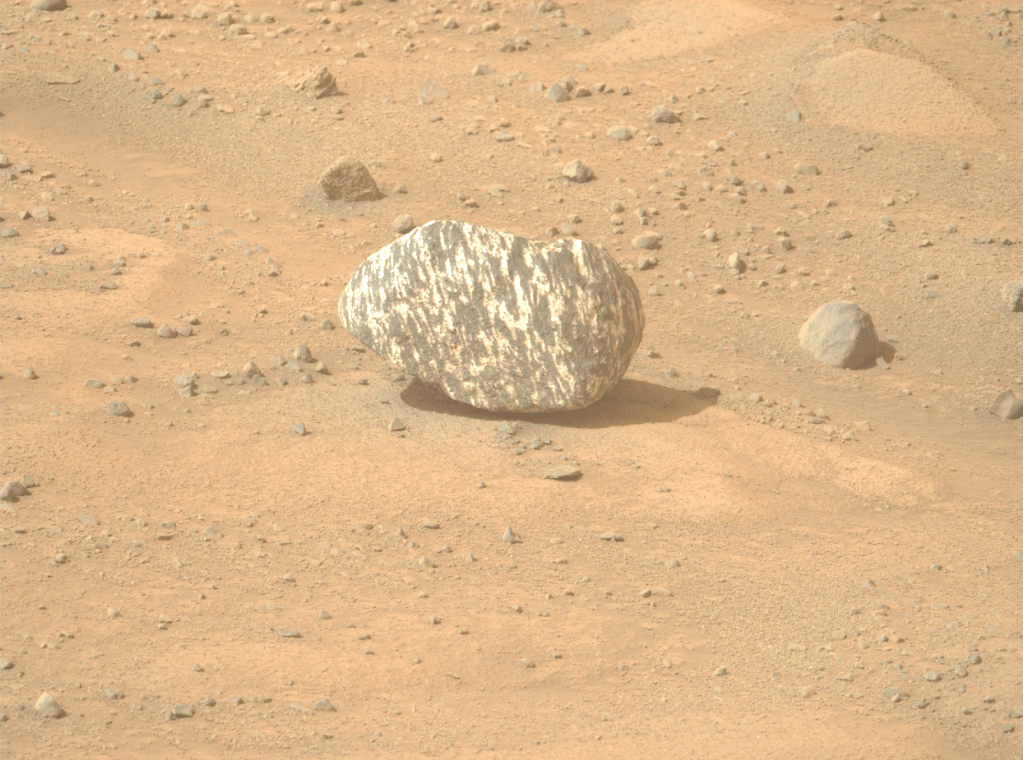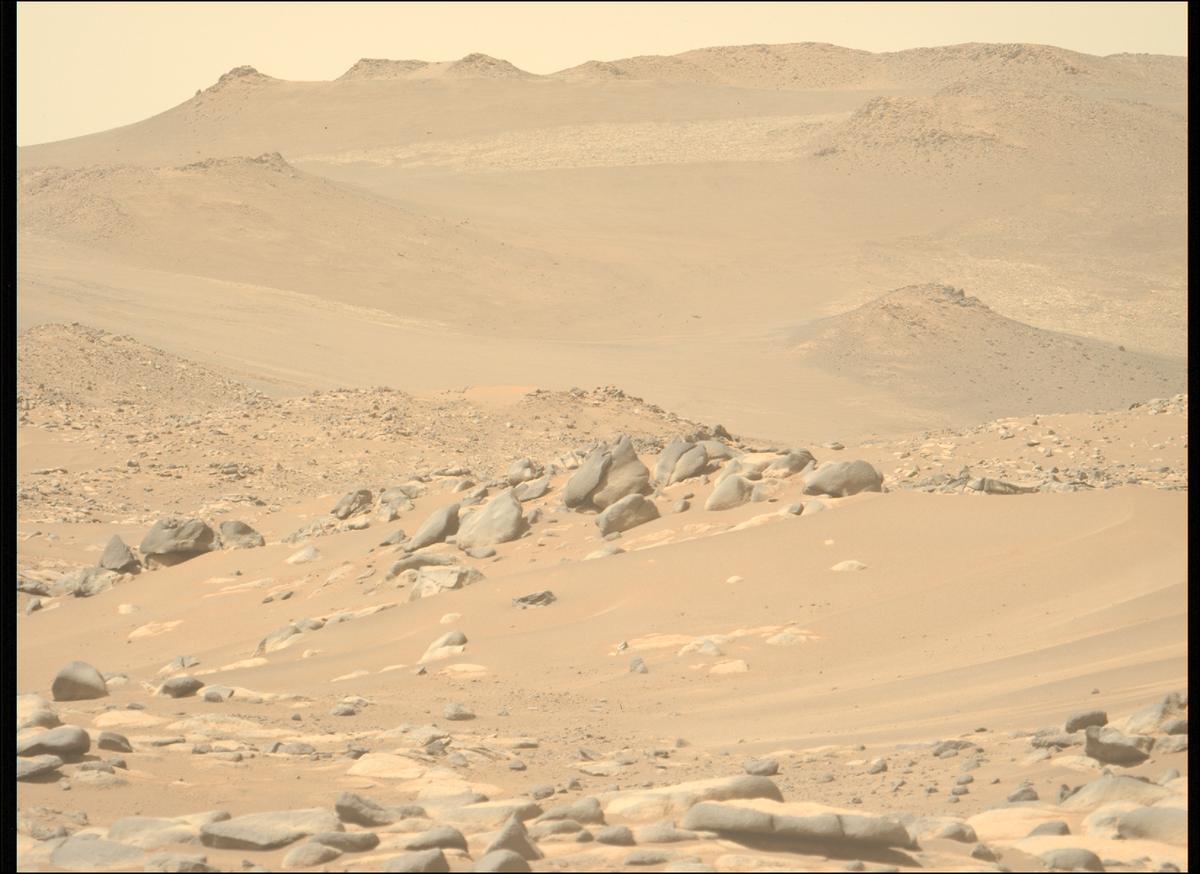- 12 Posts
- 33 Comments

 4·7 days ago
4·7 days agoWith all the apparent lithologic diversity and patches of flattish bedrock as we’ve gone higher and higher up the rim, I’d be more surprised if they hadn’t thought about coring. They’ve been shooting a lot more close-ups lately, that’s for sure, and not just on the “white rocks”. I assumed they were going to wait until reaching some accessible, heavy and stable boulder at Pico Turquino, and I still think they will. Nonetheless, it would be hard to miss the pretty distinct geologic units as we’ve sidled up to that hill, and erosion clearly has some interesting tales to tell around here. I definitely haven’t been able to complain about the rover climbing too fast and blowing past interesting stuff lately.

 5·20 days ago
5·20 days agoZOMG
We’re actually backtracking!!! What have they done with Ken Farley - has he been kidnapped?? He’d never stand for actually going back and deviating from the Mission Plan…

 2·20 days ago
2·20 days agoOne pill makes you larger
and one pill makes you small
and the ones that Mother gives you
Don’t do anything at all

 2·21 days ago
2·21 days agoWhen lost on another planet, our little green friend reminds us: Remember your training. Save you it can.
I’m not surprised that Mars Guy is going back to the textbook, so to speak, because we just don’t have experience with a geologic setting quite like this - the moderately well-preserved rim of a ~50 km-diameter impact crater - from prior Mars exploration or Apollo (Earth, of course, has done a lousy job of preserving craters of this size). The closest example is Opportunity’s exploration of Endeavour Crater, which is much smaller, with a far smoother, more degraded rim. Apollo 15 landed near the edge of the Apennine Mountains, formed by the immense Imbrium basin impact (~1100 km diameter), but the astronauts didn’t have the chance to ascend the foothills to any great height during their short and very busy stay. Opportunity had access to extensive outcroppings of bedrock at Endeavour, not to mention the kind of smooth, light-toned “paver stones” that Curiosity and Perseverance have been driving over for years. The Apollo astronauts saw nothing of the kind, unsurprisingly - the Moon being completely blanketed by that powdery surface.
Those other landing sites feature nothing quite like the distinct, boulder-studded knolls and ridges that Percy is investigating, which seem related to the original crater formation process itself. These gentle hills roughly follow the regional SW to NE trend of the rim mountain Percy is climbing (zoom in just a bit on the ESA map to see the steep face of the spur north of the rover), and several feature intact, massive blocks of bedrock that I’d love to sample (see Paul Hammond’s Pico Turquino post for the best example yet). Good episode by Mars Guy, and I can’t disagree with him here for the most part, but believe me, he isn’t laying the hardcore stuff on us yet: impact crater geology melts brains, not just rocks!

 3·26 days ago
3·26 days agoI’m afraid I can’t upvote this sentiment, Paul. I feel like we need to get you to, I don’t know, the Atacama? Utah, Kazakhstan, Western Australia? Nunavut, or the Dry Valleys? OK, all those places are a bit much on the oxygen and the humidity, and you wouldn’t be tasting the grit and dust in your mouth, but surely they could provide some respite to weary Martians? Dear planetary science community: remember the Paul Hammonds of this world as you work! We’re not mathematicians or pure theorists - planets fully engage the senses, and some people have been waiting a long time!
(TBH, I really go back and forth on the wisdom of sending astronauts ASAP, as certain incautious parties advocate. We should have done one sample return mission already - the easiest and arguably most relevant to astronaut safety was unwisely cancelled by NASA and has never been revisited, for reasons I can’t understand - and I long to get those cores from the Jezero basin back. I’d really give up a lot to have them, and I often think it’d be irresponsible to send people before we’ve assessed the toxicity of the regolith and dust. Still, the 1960s show me how important it is to have urgency, too. I’m assuming it was incredible fun to watch the entire lunar program evolve out of nothing, and even the Voyagers launched when they did to hit a deadline. I can’t imagine where this science would be without Apollo or Voyager!)

 2·27 days ago
2·27 days agoAre we really passing up all those tasty-textured boulders on the hill??
Come on, rover team! If you won’t give Percy the pleasure, send me! I’ll core those rocks for free. We really need astrogeologist boots on the ground…

 2·28 days ago
2·28 days agoThanks for posting these. Do you prefer this JPL version of the overhead view to the contour-lined ESA one?

 2·1 month ago
2·1 month agoYou mean “notional path to the SSW”, Paul, no?

 3·1 month ago
3·1 month agoSTOP STOP I’M GETTING A NOSEBLEED
(OK, I know Opportunity was a lot higher up in elevation. But that’s not a fair comparison - “Oppy” was born lucky and everybody knows it. The wind was always at that rover’s back and it never had to land in a 1500 km-wide hole punched out of the highlands…)

 22·1 month ago
22·1 month agoDon’t be all proud of yourself. The rover drivers will be given control of the death ray (sorry, the “breakdown laser spectrometer”) when they summit the rim as a reward for their hard work. They’ll be carving out the words, “We Persevered, ******s” into the finest basement rock any rover has ever tasted.
Beat that.

 4·1 month ago
4·1 month agoOy. Less than 5 vertical m cleared after a whole week of short slippy drives. I’m not sure what I was expecting to find on this rim, but this terrain wasn’t it.
EDITED TO ADD: I meant - only 5 m on this drive, after a whole week of slippy drives, with less than 10 vertical m cleared on any one drive. And this is hardly the softest-looking crater rim we’ve seen on Mars…

 2·2 months ago
2·2 months agoWhile I’m being chatty, I’d like to ask you if you have any suggestions re: contributions to this community or instance or whatever we call it. I often see things in the raw images that I feel like pointing out here. In reading social media since this mission started, though, I see vast knowledge gaps in people’s understanding of basic geology (or “earth sciences”, if we can use that term for Mars - maybe “environmental sciences” is a better term), and I sometimes feel I should try to shine a light in those gaps. I’ve thought about breaking down some of the big science papers/results from this mission here, but I wanted to ask you about this first, as I think you have a better feel than I for what people might be interested in actually reading.

 2·2 months ago
2·2 months agoYou’re talking sense, Paul. As you say, opinions certainly differ, especially among people of different scientific disciplines (e.g. meterology vs. geology), and that even extends to the mission PIs. Steve Squyres was certainly driven and focused in achieving his science goals, which meant that the MER missions drove hard as well. John Grotzinger was criticized for not connecting the dots and “lacking focus” on a big flagship rover. From everything I’ve seen and heard, Ken Farley is being more careful in balancing priorities (and I’d say his job is a lot harder here, considering the needs of sample return!) All that being said, even pure geologists will certainly disagree amongst themselves, though we don’t see that here as interested members of the public.
I’m not privy to the inner workings on this project by any means - certainly not directly. Having observed prior missions from a somewhat closer perspective, however, I see Mars 2020 as very, very driven by the work of other missions and a surprisingly broad community. Orbital spectroscopy and geologic mapping has guided this rover in detail from the very start, to a degree greater than I remember even for MSL, and I’m not aware of much debate about the rover’s planned route at any point since before landing. I was personally quite surprised by the short amount of time that Percy spent in Neretva Vallis (amazing place!), to say nothing of acquiring only one sample. Yes, there aren’t many spots as interesting as Bright Angel along the traverse path, but I still don’t agree that one sample was enough, and I somehow doubt that I’m alone in that opinion.

 3·2 months ago
3·2 months agoI’ve seen dust storms before - the largest ones, the global ones, even through backyard telescopes. If you’re working right on the surface, they’re not fun.

 5·2 months ago
5·2 months agoI’m not often surprised anymore by whitish or light-toned materials near a rover since Spirit uncovered all that whitish silica with its dragging dead front wheel, all those years ago. It seems we often find that Mars is red only until you literally scratch the surface.
I have to say that Percy often drives right past plenty of rocks I’d like to investigate more. I know that Ken Farley et al. are doing just that with remote sensing (the results of which we aren’t privy to for quite a while), so they have some idea of what they’re looking at, but I’m often tantalized by a lot of this stuff.

 5·2 months ago
5·2 months agoFor God’s sake, stop it with the conspiracy theories. Trace Gas Orbiter would absolutely not miss the, well, methane emission, from a single baby cow, let alone an adult specimen worthy of being prepared as wagyu. Everyone knows that a Japanese master chef would quit (or worse…) before disgracing himself thus. He would never abandon a thickly-marbled specimen on a great big windy crater rim like this.
This is Mars. If you want your vulgar gyudon, there’s plenty of that on the mad blue planet next door. Martian wagyu should be part of the finest sukiyaki, to be eaten in formal dress, in deeply contemplative silence.
… I should add - if you can get a sample of this rock for us, we’ll even let you eat part of it. It might be a bit salty, but you can be pretty sure Martian beef is nitrate-free…

 6·2 months ago
6·2 months agoThe idea that this “zebra” or “bad camo” rock could be metamorphic is really something, an interpretation I didn’t even seriously consider. If this is metamorphic, one would think at first glance that it isn’t more of the same material we’ve sorta-detected on Mars already, which is probably the hydrothermal or shock metamorphic kind. Mars Guy considered metamorphic rock in his last video only to discard it…
Then again, the Nili plateau region just beyond the crater rim is supposed to be so damned old, even for Mars, that it could preserve evidence for all kinds of craziness, and I’m not sure we can rule out that this rock isn’t impact ejecta from the plateau. Maybe this thing doesn’t preserve evidence for something as Earth-like as plate tectonics, but that banding pattern needs a deeper look. It may not be a match for the neatly-striped metamorphic rock of Earth, but Martian metamorphism that may have occurred deep within the crust is something we shouldn’t ignore. At the very least, I’d like Mars Guy’s comparison of this rock to freaking dolomite to be put to the test. There’s more evidence for plate tectonics on Mars than there is for that stuff!😅

 2·2 months ago
2·2 months agoI’m assuming this is one of the larger climbs/vertical displacements that Percy has managed in a single sol. This old crater rim is definitely the steepest terrain the rover has tackled, which might limit the rover’s progress on driving days, but I wonder if the all bedrock we’ve encountered along the way is enticing the scientists enough to take it slower.


Interesting! CacheCam isn’t used very often. Would dust on the lens impact operations significantly?